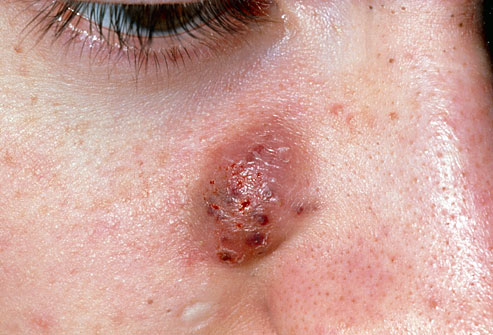Cystic Acne
Cystic acne is by far the most severe form of acne vulgaris, which develops from nodules deeply embedded beneath the skin’s surface. It is very painful and often leaves scarring. It can also affect anyone, but it is more common in teenage boys and young men. Acne seems to run in families.

It's infection does not remain restricted to superficial skin, but also invades the inner layers of the skin. In most cases, facial area shows acne but dermatologist say that it can occur anywhere on the body. It can also occur in the form of big swollen red pustules, thus, giving the appearance of chickenpox.
If your parents had cystic-acne, you are more likely to experience severe acne yourself.
Cystic-acne is one of the most difficult types of acne
to treat. Though it is most likely caused by the same bacteria (p. acnes)
as regular acne, it's lesions are far more painful and have more risk of
scarring compared to mild or moderate acne.
Causes
Like almost every type of
acne, the cystic-acne is triggered by hormones. In cystic-acne, the skin's oil
glands become hypersensitive to excess male hormones and react by overproducing
sebum. So much sebum is produced that the oil gland itself becomes
engorged, swollen, and hardened with the excess. Unable to push almost any of
the extra oil to the surface, the gland bursts underneath the skin, creating
the large swollen mass below the skin's surface. Alterations in hormonal
balance that are common during pregnancy can also cause cystic acne. Stress,
too much use of cosmetics and air pollution may actually worsen acne.
Formation of cystic acne
Cystic-acne develops when untreated nodules advance in growth and development. When nodular acne inflamed and engorged with pus inside
it, its follicular wall may end up rupturing deep beneath the skin, releasing
the pus it contains. The bacteria contained in the released pus leak deep into
the skin, will rapidly multiply and this will produce a more profound
inflammatory process, where your body will try to combat the bacterial
infection.
While
this inflammatory process is taking place, the cystic-acne will gradually start
to expand into the surrounding skin tissue, forming larger and larger cysts.
The depth and extent of acne cysts can vary greatly and they can appear in a
combination with other types of acne, such as blackheads or whiteheads.
Features of cystic acne
- It's nodule appear as raised, red bumps that extend deep beneath the skin.
- Generally they do not have a whitehead showing, but this is not always the case.
- They are almost always painful to the touch, or even when not touched.
-
The lesions can often be felt beneath the skin before they are seen.
Prevention
- Practical measures to avoid making acne worse includes:
- Lifestyle change,
- Implements healthy diet,
- Body cleansing,
- Exercises
- Different traditional and natural
therapies.
Treatment
For some people with
cystic-acne, traditional therapy may work, but often that is not always the
case. If over-the-counter options aren't successful after at least four weeks
of daily treatment, your next step is to see a dermatologist. Several treatments are available to provide
some relief and prevent scarring.
Tags
severe acne, acne vulgaris, nodules, pustules, over-the-counter, blackheads, whiteheads, treatments
Irresistible Acne Remedies. This free newsletter is delivered monthly, straight to your INBOX. It covers all new pages since the last issue. Sign up here...


New! Comments
Have your say about what you just read! Leave me a comment in the box below.